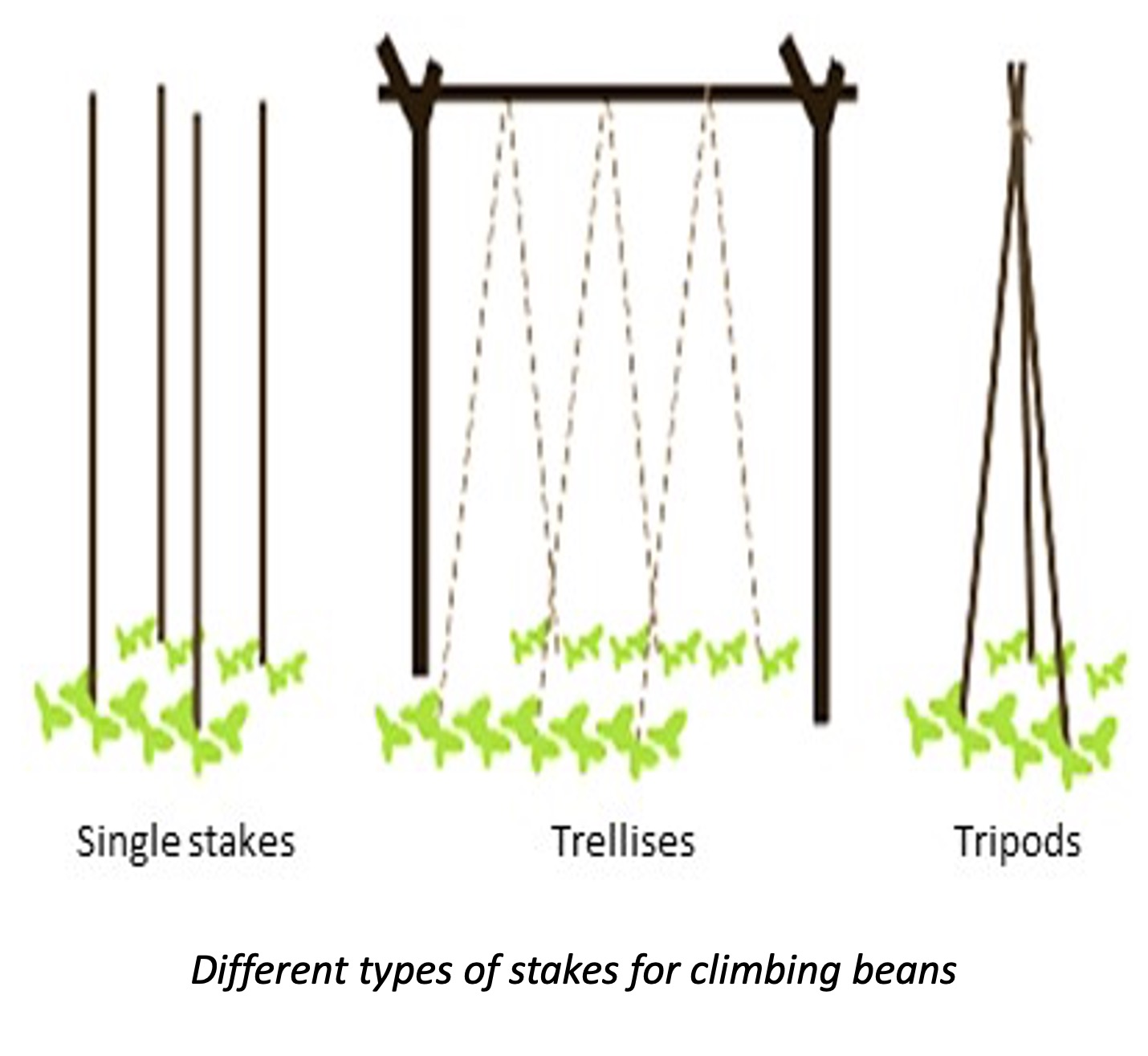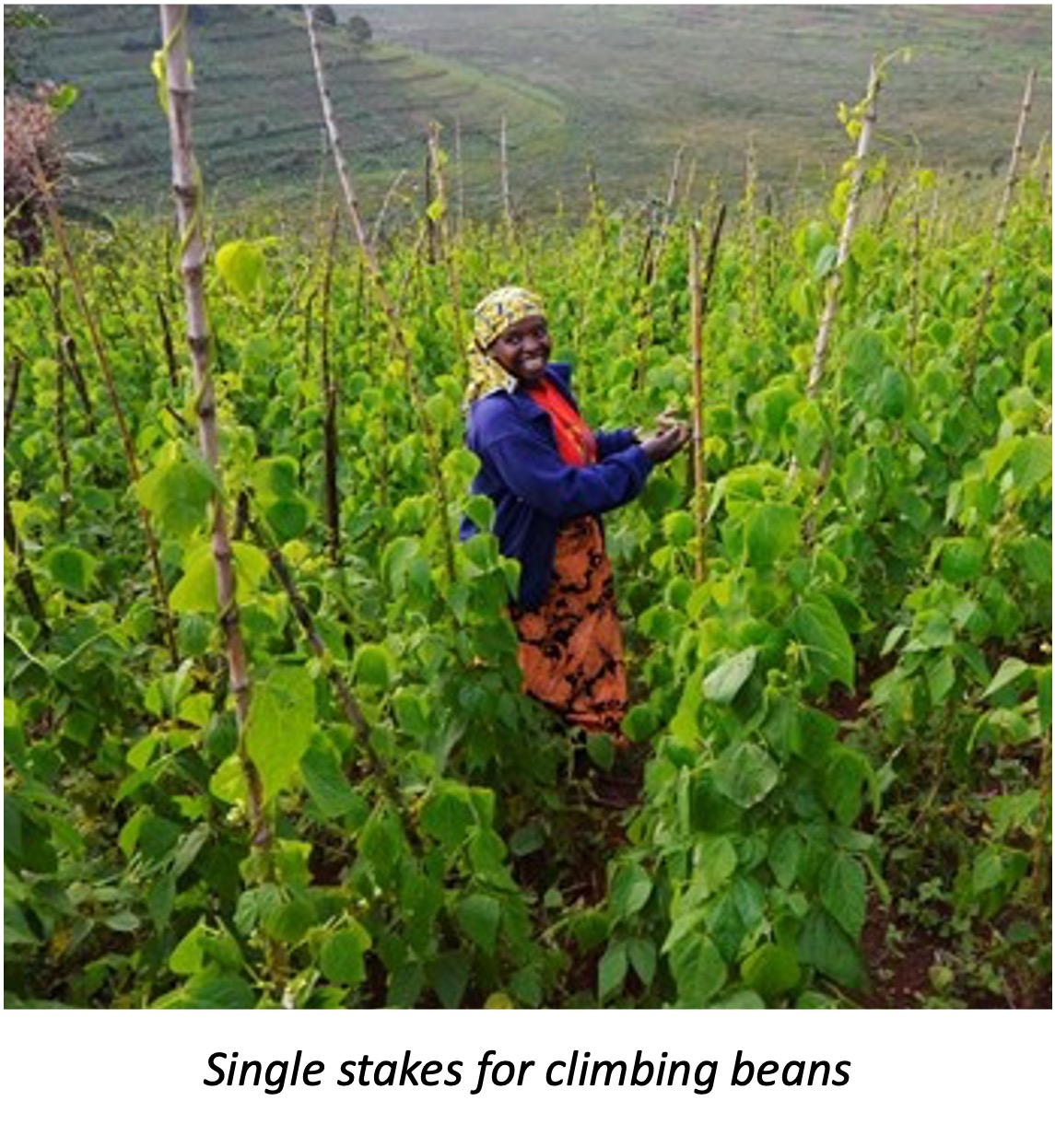Low-Cost Staking for Climbing Beans
Summary
Adopting climbing bean offers a potential for increasing bean production in Africa, however, a major challenge to growing climbing beans is the requirement for plant support. Many farmers find this added expense difficult to meet and inadequate staking results in yield loss of 50% to 90%. This challenge is the most limiting factor for optimized yields and advancing wider adoption of climbing beans. Optimal staking of 50,000 stakes per hectare is challenged by a paucity of available wooden stakes. Overharvesting of stakes is also associated with deforestation and delayed afforestation, placing it at odds with environmental gains. Adequate staking requires an understanding of optimal plant density, appropriate length, and durability. A suite of farmer-acceptable, lower-cost and environmentally-friendly staking innovations is available. In particular, tripod arrangement or a strategic combination of stakes and string trellises results in the reduction of the wooden stakes needed.
About the Solution
Several low-cost staking methods present a range of options. Selection is largely dependent on availability and durability of different materials, labor requirements and costs. These technologies promote innovations that reduce the number of stakes per unit area and make the best use of readily available materials. Generally, the highest yields are obtained with stakes that are at least 2 meters tall and a staking density of at least 20,000 stakes per hectare. Up to that point, the taller and more sturdy the stakes are, the higher the yield! There are also returns to increasing the number of stakes to 50,000 per hectare. Stakes may be obtained from agroforestry species and tall grasses such as elephant grass (Pennisetum atropurpeum). Fast-growing agroforestry species suitable as stakes include Acacia angustissima, Alnus acuminata, bamboo, Calliandra calothyrsus, Gliricidia sepium, Sesbania sesban and Vernonia amygdalina. Such low cost staking arrangements include 1) single staking with less expensive materials, 2) wood and string trellis combinations, 3) tripod staking, and lastly 4) live plant support. When the beans reach the top of the trellis, the growing point of the main shoots should be pruned. This reduces height for easy harvesting and increases the growth of lateral shoots.
Low-cost staking of climbing beans assumes adequate supply of agro-forestry tree species or larger shrubs. Tripod staking has been adopted in regions with shallow soils and where the available staking materials are not very strong such as those from Pennisetum and involves tying 2, 3 or 4 long stakes together. If sticks are too short, the tip of the bean plant will flip over and fewer pods will form on those unsupported branches, while if stakes are too long (e.g. > 2.5 meters) the beans plants will produce excessive vegetative growth, and have fewer and less reachable pods.
Single staking relies upon stronger, longer woody stakes. These may be produced around farm boundaries or in small woodlots. Stakes may be recovered from larger trees as well such as Eucalyptus or Grevillea but care should be taken to not actively deforest areas, especially hillsides. Staking is often combined with string or wire trellises. From this horizontal stake or string, many ropes fall vertically over the climbing beans and act as support. Live staking uses intercrops stems such as maize and cassava to support the climbing bean in combination with additional woody stakes.
Climbing beans can be planted in both row and hills. In rows, seeds should be spaced 15-25 cm apart allowing 50 cm between rows. Two seeds are placed in each station to give a plant population of approximately 200,000 plants ha-1. The sticks are sharpened prior to staking for ease in ground penetration. The stakes should have a rough surface to help the plant to grip and should be at least 2 meters in height. Staking is required about two weeks from seedling emergence. In single staking, a stake can support 1 to 4 plants with an inter-stake space of 0.4 m while each stake of the tripod can support 1 to 3 plants. Connecting stakes increases their strength. Wooden string trellises can accommodate two adjacent bean rows. Vertical strings may be replaced by nets with openings of 10 cm (e.g. “cucumber netting”) secured to the ground with stakes or wires. Lower cost vertical support may be obtained from reeds, strips of tree bark or even stems of a creeping plants and vines. In live staking, after maize harvest, the strongest stalks are left to serve as stakes for the climbing beans the following season. Alternatively, four maize stalks are tied together at the top to form a tent-like structure, forming the basis for a maize-climbing bean rotation.
Commercialization
Commercially available
Solution Images
Institutions



